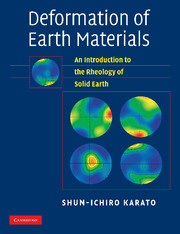3 - Phenomenological theory of deformation
Published online by Cambridge University Press: 05 June 2012
Summary
The formal theory of deformation plays an important role in formulating energy dissipation (i.e., seismic wave attenuation) and non-linear rheological relationships. This chapter presents a brief summary of the phenomenological theory of plastic deformation. This includes the classification of deformation (elastic, viscous, plastic etc.), the mathematical formula for constitutive relations, formulation of transient creep and the mathematical formula appropriate for non-linear rheology.
Key words elasticity, visco-elasticity, anelasticity, constitutive relations, Levy–von Mises equation, mechanical equation of state, transient creep, creep response function, creep compliance function, Kramers–Kronig relation, Maxwell model, Voigt model, Zener model, Burgers model.
Classification of deformation
The response of a material to applied stress can occur in a variety of ways. Under some conditions, an equilibrium state can be achieved upon applying a stress, whereas time-dependent or steady-state deformation can also be achieved. To understand the microscopic basis for this difference, it is useful to consider the nature of atomic displacement caused by an applied stress. At static equilibrium, each atom occupies a position corresponding to the minimum potential energy (Fig. 3.1a). Upon applying a stress (a force per unit area), atoms move their positions from their stable positions. If the stress is small, or the temperature is low (or time is short), then only small, instantaneous displacement will occur. Consequently, when the stress is removed, atoms go back to their original positions. This type of instantaneous and recoverable deformation is called elastic deformation.
- Type
- Chapter
- Information
- Deformation of Earth MaterialsAn Introduction to the Rheology of Solid Earth, pp. 34 - 48Publisher: Cambridge University PressPrint publication year: 2008



